Content sharing is that – often secret – holy grail of many content marketing, social media and digital marketing practitioners. Although content sharing is just a part of the whole content marketing story and social media marketing reality, all marketers want to see their content shared far and wide with as many people as possible. It’s a topic that lives in all forms of marketing, ever since the early days of the WWW and email marketing, and in a broader context of storytelling.
So, why do people share content? Why do they tell stories? Why do they bother at all? The easy answer: because they want to and feel emotionally compelled to. But that’s of course too easy.
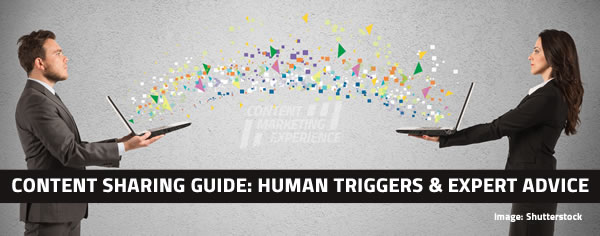
The psychology of sharing
In our customer-centric content marketing manifesto we mentioned that people are by definition self-centered (not the same as selfish). Sharing in general – and the sharing of content in particular – offers a personal benefit, even if we don’t realize it.
It involves emotions, psychology and quite some chemical processes that go hand in hand with the act of sharing. According to psychologist Jonah Berger, “the sharing of stories or information may be driven in part by arousal”. That seems pretty self-oriented.
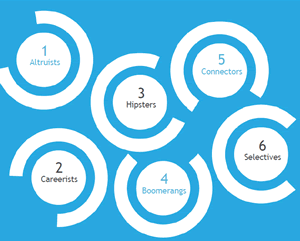
Note: of course it’s always important to watch out for one of the main flaws in much scientific research: cause and consequence. Do we have a heightened level of xyz in our brains because we do something, does doing that something increase the level of xyz, which is then merely a “symptom”, or is there another explanation?
People have tried to define all the emotions and motivations of why content – and of course stories – get shared for ages. In fact, we tried to define and describe each emotion we – humans – have since a very long time.
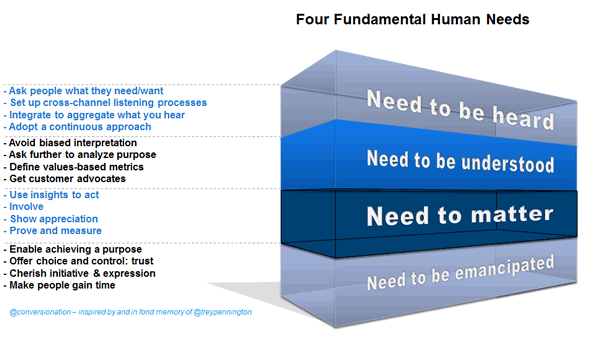
And each emotion got a label so there are literally hundreds of ways of looking at emotions and motivation (from the – among marketers – oh so popular Maslow to far deeper digging psychoanalytical models and many more down-to-earth attempts).
Just as we like to label things and people (to make sense of the world around us) as in the depicted model of ‘six personas of online sharers’ on top of this article, we like to label emotions and connect them with the way we act, feel, behave and share.
The many dimensions of content sharing
Content sharing -obviously – also has a somewhat technical and more “formal” dimension.
Some examples:
- Is your content shareable? In plain English: is there a sharing (SWYN or Share With Your Network) button and whatnot next to the content you want shared or a FTAF (Forward to a Friend) possibility in your emails (since social virtually everyone now says SWYN)?
- Is your content share-worthy? That’s more than about psychology. It’s also about knowing whom your audiences are and what they value, what they deem relevant enough to share and, yes, “perceived quality” (in format, words and images) also plays a role in that (on top of “perceived sharing value”).
- What is the context? Sharing is done differently, depending on device, environment, contextual placement, channel, language, image, you name it. You probably read the “Top retweet tips” and similar blog posts.
Content, social, content curation and storytelling
Without content and stories, the Web and the world would be a lot less populated. We have to have something to talk about, don’t we? In the end that’s also part of what content marketing is about.
Storytelling is essential in – most forms of – content (marketing) and one of the characteristics of stories is that they get shared. Yet, again, storytelling is about much more than content marketing (just as relevant content isn’t always the same as storytelling as some claim).
Content marketing is closely related to social media marketing today, depending on the business goal and context. But it’s clear that the combination of social and content is a strong one. And, in a sense, content curation, can also be seen as a form of content sharing.
Sharing isn’t anything new, humans have always shared content in one way or the other. From oral histories around a fire to troubadours to water coolers and coffee bars, we digest content and then we want to share it and discuss it. It’s a fundamental fuel of communities offline and online.
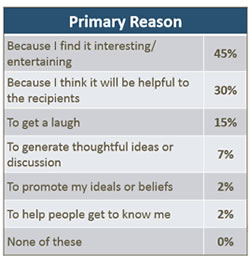
More reasons why people share content: a bunch of emotions
There are literally hundreds of blog posts on “xyz reasons people share content on social networks”. An example: this Social Times blog post in which the author says there are seven main reasons why people share content online: 1) laughter, 2) inspiration, 3) cuteness, 4) originality, 5) shock, 6) surprise and 7) nostalgia.
In another blog post, Bryan Kramer, who also rightfully says there is no definitive list of the spectrum of emotions, refers to psychology, the six emotions by emotion expert Paul Ekman.
Bryan, author of “There is no B2B or B2C: It’s Human to Human #H2H”, applies them to social sharing: fear, anger, sadness, disgust, joy an surprise.
All of these have been reasons for sharing – and connecting/acting – long before the web, social media and content marketing ever came along of course. And you could probably add many more reasons. Just look at the primary reasons people SAY they share content in the illustration.
But what’s the common denominator here in these emotional reasons why people share content? Validation? The need to express ourselves and be heard? Emancipation? Self-actualization? If you look at the list above every single one of those motivators is interpretive. What’s shocking to one person may not be to another and the same goes for the rest.
When you see something that’s funny or shocking etc., you want to share it to see if others agree. And of course when it comes to humor, laughing alone (as Seth Godin has pointed out) isn’t any real fun now is it? We’re social animals at our core, so doing most anything alone isn’t as much fun as doing it with others (go ahead and snicker).
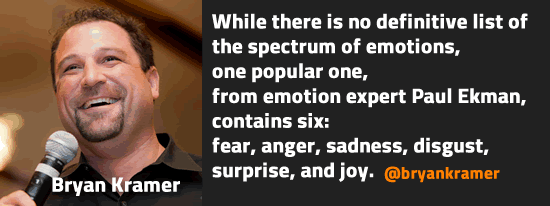
Validation and self-actualization as primary motivators
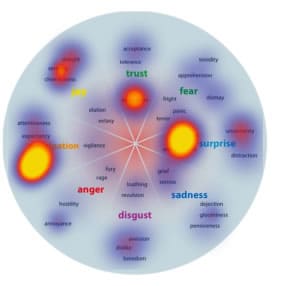
Are any of the mentioned reasons why people share content universal? Or are all of these in the eye of the beholder? Validation is a primary motivator in human society and since the virtual world is a reflection of the analog one, it is here as well.
Self-actualization is fundamental: since the day we’re born our human condition is trying to – dare to – find and construct/show a self, evolving (or not) in-between the once perceived safety of “being take care of” and the innate human desire to be individualized. The art of relationships and our place within them.
The importance of validation shows when two individuals debate an issue online on forums or any other social site (including comments): they are very unlikely to change their opinions and much less likely to admit that their opinion is invalid. It’s extremely rare for one debater to ever admit they are wrong or have a flawed argument – it does happen, but not very often. What they are really seeking is validation of that opinion from other members of the community. Many of these members may not even participate in the discussion, but they do offer validation of the opinion they most closely relate to via such things as “like”, “rep” and other similar features. This need of validation also plays an important role in the reasons why people share content and, let’s admit, there is a strong connection between content and community.
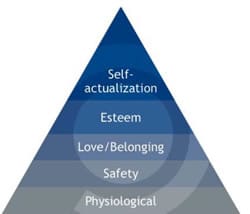
There’s a reason why Facebook, Google, forums, newspaper sites and so on have these “like” or “agree/disagree” buttons. This allows people to get and give validation and both those actions provide a prestige/satisfaction factor. Getting approval (validation) makes us feel good and giving validation makes us feel involved in the discussion and community even if we are committed lurkers (or inactives, spectators, etc. as Forrester called them).
However, the ultimate reason is self-actualization within a relational context;
In the end, no matter how emancipated or individualized we are, we remain social beings and thus need validation and relationships. Just as we need anger and a wide scope of other emotions to express our true self. It goes for content sharing too, even if helping by sharing in the end also can be very gratifying for the self. But does it matter?

Content marketing: the often shared on content sharing
Let’s instead see what marketers and storytellers, who have their content often shared, think themselves about the reasons why this is the case?
We recently asked them with our sister brand Fusion Marketing Experience. We based our selves on a list, posted by the folks of socialfresh, summing up the top 50 people that are most retweeted by digital marketers, according to a report. Lists are lists and reports are reports.
Now, why do they their tweets – and thus content – get shared so often? The question we asked: what would you recommend to people who are trying to get their content and stories shared?
Jay Baer: clarity, real needs and terrific headlines

Twitter profile: NY Times best selling author, marketing consultant, keynote speaker. President of Convince & Convert. – @jaybaer.
Blog: Convince & Convert.
Two tips here.
- First, understand with extreme clarity for whom you are creating content, and what their REAL needs are. For example, nobody needs socks, they need their feet to be less cold. That’s why much of the best content isn’t about products and service precisely, but is about larger (yet still relevant) topics. This is the magic of marketing sideways.
- Second, the unit of attention continues to shrink. If you want your content shared, you need to invest considerable time in crafting terrific headlines.
Lee Odden: the four steps of getting your content shared

Twitter profile: CEO @TopRank Online Marketing. Author, Speaker & Consultant Focused on Content Marketing, Social Media, PR & Search – @leeodden.
Blog: TopRank Online Marketing Blog.
- First, create content worth sharing. Content that is thoughtful about providing useful information for a specific audience is far more likely to be shared.
- Second, it’s important to develop networks and channels of distribution. Social Media provides opportunities to develop these types of networks, but it takes time as does the growth of an email list.
- Third, you can pay your way to exposure through search and social advertising as well as sponsorships and editorial based advertising.
- Fourth, connect with individuals and communities that already have an audience and find a way to use your content to create value for them. If you can accomplish that, they will share like nothing else.
Michael Brenner: focus on the real goals of your content

Twitter profile: Managing Editor for @Biz_Innovations. Speaker, Author and Blogger @Forbes and @B2BMKTGInsider – @BrennerMichael.
Blog: B2B Marketing Insider.
I have found that focusing just on getting your content shared can be a tricky and even dangerous proposition. I think it’s important to focus on the real goals of your content (engaging a new audience, driving your brand affinity for a topic, etc.).
Then social sharing should be an outcome of creating content that matches the goal, not the goal itself. So the answer is really simple: create content your audience wants and if they like it, they will share it.
Shelly Kramer: write to serve and build relationships with information

Twitter profile: Marketing/brand strategist, idea generator, digital content magician, scribbler, information junkie. v3im.com – @shellykramer.
Blog: V3 Integrated Marketing blog.
In 2006 there were 35 million blogs, today there are 237ish million. There’s a lot of noise and everyone is clamoring for attention by way of content. What I tell people is that writing content is the easy part, getting anyone to read it takes skill — today more than ever.
Start by building your networks before you need them. A great network is exponentially more valuable than a killer blog post that nobody knows exists.
Also, remember two things when it comes to the creation of and sharing of content: that you get what you give and nobody wants to be marketed to. Write to serve your audience, build relationships with information, put people first. That’s a winning equation.
Mark Schaefer: don’t overlook the “network” dimension

Twitter profile: Chieftain of the blog {grow} and social media bouncer. Consultant, educator, podcaster, author of Return On Influence, Born to Blog, and The Tao of Twitter – @markwschaefer.
Blog: BusinessGrow
This is a very complicated question because there are so many factors that weigh into a decision to share content. Obviously, the content must be share-worthy. But beyond that, you must actively, systematically, and continuously work to build an audience who has a propensity to share your content. That is not a quick or easy thing to do. Most people get “content,” but few understand “network” — the second critical component of a social media strategy.
Mack Collier: religiously track
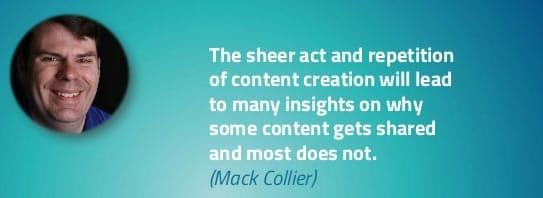
Twitter profile: Helping companies Think Like a Rock Star & with a Southern accent. Founder of #Blogchat – @MackCollier.
Blog: mackcollier.com.
My answer will be the least sexy one you receive. If you want to learn how to make your content that gets shared more often then you need to create more content. I can give you many tips on creating more shareable content, but the best way for anyone to learn how is to do. You need to start creating content, the sheer act and repetition of content creation will lead to many insights on why some content gets shared and most does not. For example you may write 25 blog posts and none of them get over 5 retweets on Twitter, but that 26th post gets over 100 RTs. Why? You need to look at that 26th post and try to figure out what caused it to get shared while the other posts did not.
My advice is to start creating content and religiously track how that content is shared. When you create a piece of content that proves to be popular with your audience, try your best to understand why, and what you did differently with that piece of content. If you do this repeatedly, over time you will learn how to create content that gets shared more often.
- Content sharing: 5 reasons no one shares your content.
- Content sharing: what content people share and why.
- Content in context: how sharing equals creating content.
- Using storytelling to strengthen your brand.
- The art of storytelling in 6 content marketing context questions.
- A guide to social content marketing.
- SWYN: findings on content sharing behavior.
More explanations on why people share content
There have been many other explanations regarding the reasons why people share content and share in general. ShareThis, for instance, looked at the reasons why people share content – and stories – across social networks and they all have a community and emotional dimension. In decreasing order of importance, respondents answered:
- To help someone who would benefit.
- To give back, as I benefit from sharing.
- To inform others about products I like.
- To show my enthusiasm.
- To show my dissatisfaction.
- To be part of a community.
- To be seen as an expert.
- To be seen as “cool”.
Platforms such as ShareThis and others have been sharing such lists (as well as those of the most popular digital sharing channels), ever since they started. By the way: email remains a pretty strong one.
Anna Farmery of ‘The Engaging Brand’ defined five other reasons why people share (social media content).
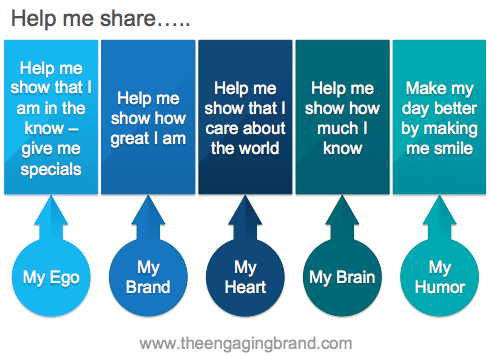
And below is an infographic from StatPro, as mentioned on MarketingProfs, summarizing some ideas and takeaways from the earlier mentioned New York Times paper and some other sources.

And, finally, here’s an infographic by the folks of WhoIsHostingThis? on five reasons your content is not going viral.


